If you have a messy apple tree that hasn’t been pruned for a while, don’t be daunted! We’ll cover the basics of pruning apple trees in 14 easy steps, along with a few advanced tips.
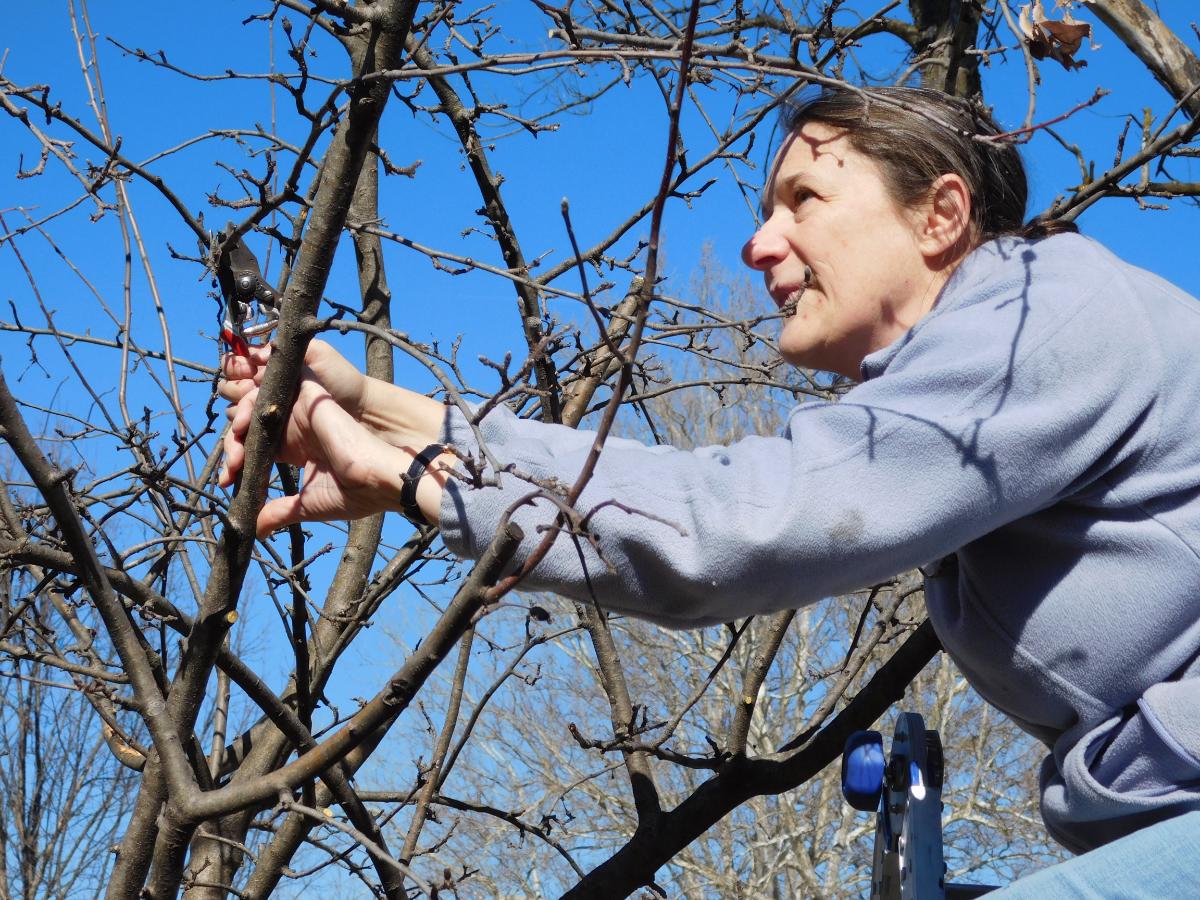
Jump to:
Why Do Apple Trees Need to be Pruned?
Several reasons, really. The Extension service at the University of Wisconsin-Madison states, “Properly pruning apple trees will maximize healthy fruit production. Pruning is also necessary …
- To remove dead, diseased, and damaged wood
- To increase light penetration (for photosynthesis and ripening apples)
- To heal wounds and reduce disease
- To manage the fruit load
- To maintain the shape and size of the tree.”
Shaping the tree creates an open-centered tree with good form with plenty of space between branches for leaves and fruit to grow.
Prune Apple Trees in Late Winter
Light pruning through the year is fine. It’s okay to fix a tree when a limb breaks in summer or if a low branch keeps clotheslining the lawnmower, man. It’s fine to cut back a particularly long branch that’s in danger of breaking under a load of fall apples.
However, pruning the entire apple tree works best when the tree is still dormant, according to the North Dakota State University Extension Service.
- “First, the tree will suffer less shock.
- Second, pruning in late winter minimizes the exposure of wounded tissues to the ravages of winter.
- Third, diseases are less active in winter, and you are less likely to spread diseases on your pruning tools. Wound dressings are not needed when pruning in the dormant season.”
- It’s easier to see the branches and the form of the tree, so you can make better decisions on what needs pruning.
- Diseases are dormant in winter, and the open cuts can heal before spring begins.
What You’ll Need
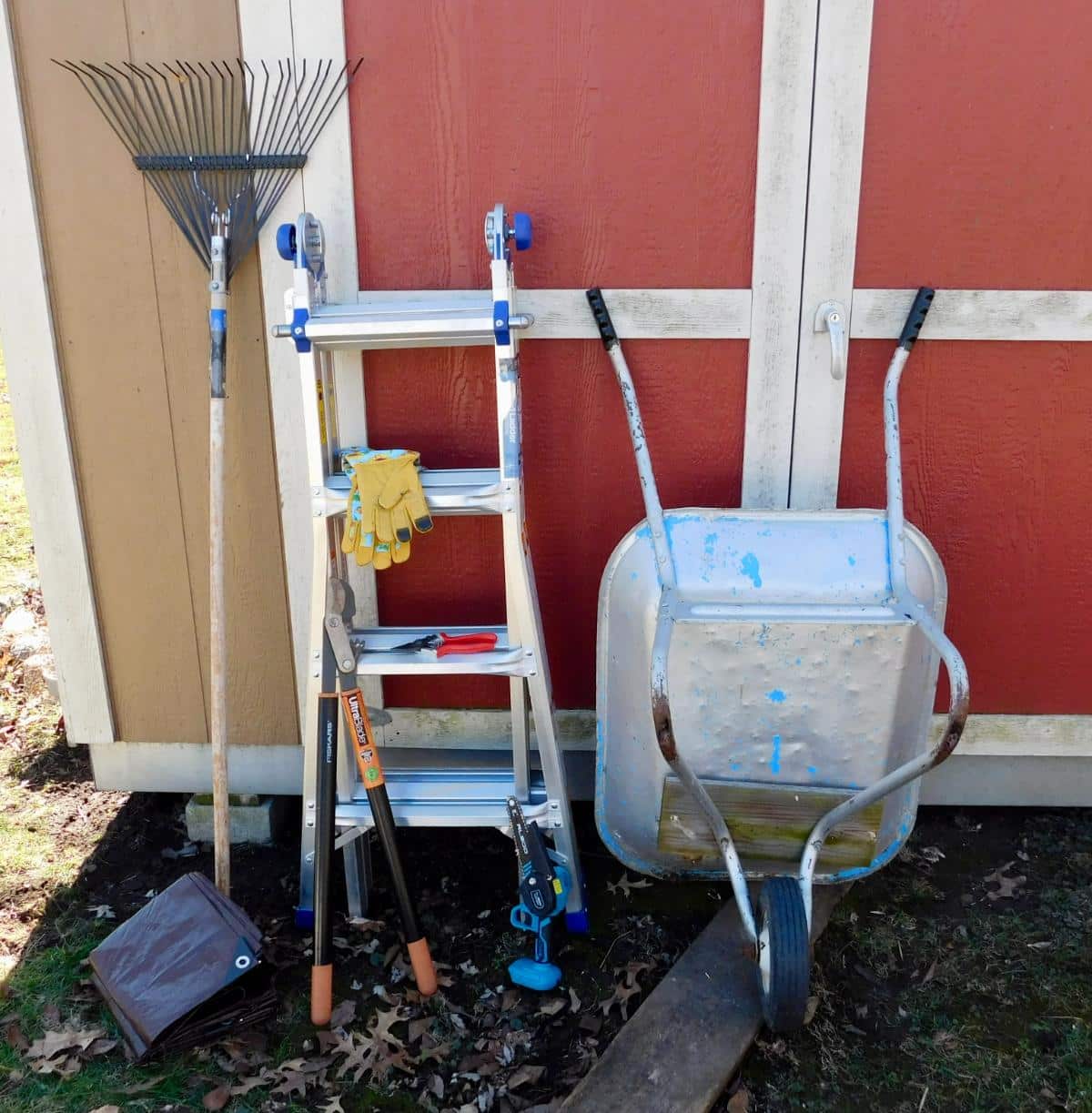
A sturdy ladder. Make sure it is stable even on muddy, soft ground.
Cart or large tarp and a rake. You’ll need this to clean up and haul away the fallen branches.
Hand pruners, loppers, pruning saw, or chainsaw. Use the tool most suited to the width of the branches you’re working on. Be sure to sharpen the blades first! You want a sharp blade that will make a beautifully clean cut. A dull blade leaves jagged, torn cuts that are hard for the tree to heal. Such cuts could invite infection and rot.
Eye protection. These keep wood chips and tree bits from bouncing up into your eye.
Gloves. Protect your hands and keep them warm, even when the wind has a bite to it. I always recommend work gloves with Thinsulate because when I worked outdoors in the city gardens in winter, these gloves and hats were fairly waterproof and definitely kept my bony fingers warm.
How Much Should be Removed?
Winter pruning should remove no more than 10 to 25 percent of the tree to avoid shocking it. Err on the side of caution, even if you end up having to leave some messy branches. Then, the tree will still be able to leaf out and blossom when spring rolls around.
If you’re trying to renew an older tree that hasn’t been pruned for a long time, leave some of the work for later. Even if the job doesn’t look finished, the tree will still benefit greatly from pruning.
Extremely heavy pruning will cause a number of watersprouts to pop up – branches that go straight up and bear only leaves, no fruit. This is the tree’s way of clawing back the energy that was stored in all the pruned-off parts. Ideally, you want the tree to put its energy toward creating productive growth (blossoms and fruits) instead of vegetation.
Avoid cutting off too many fruit-bearing branches. Packed deep inside these buds are the blossoms that will be opening in a few months. Cutting these off means you’ll have to wait until next year for apples.
Don’t Worry About Making Mistakes
Remember: There’s no one way to prune an apple tree. Even expert apple growers have a variety of ways to approach pruning. It might sound overwhelming to have so many different methods, but it actually gives more freedom. Even if you think you’ve messed up the tree, chances are that you have not. Trees are forgiving. It will survive, and so will you.
Case in point: My messy 20-year-old Jonamac apple tree.

This poor tree has been randomly cut back through the years but has never been properly pruned.
The trunk is growing at an angle from the time the lawnmower guy crashed into it over a decade ago. The tree itself is a mess of crisscrossing branches with lots of watershoots, super-high branches that require a ladder to reach, about 26 potential leader branches all trying to be the tallest, and some thick and tangled areas that get aphids and sooty mold.
Despite all that, it still bears a nice crop of apples in fall (if the accursed squirrels don’t eat them before I can pick them).
This tree needs to have to have a lot done to it, but even some pruning is beneficial, even if you make a few pruning mistakes. As Harry S. Truman once said, “Imperfect action is better than perfect inaction.” A tree doesn’t have to be pruned perfectly. There’s nothing in this world that is entirely perfect, anyway, especially when it comes to anything that grows outside.
So here are 14 steps to follow to give a messy tree lots of love.
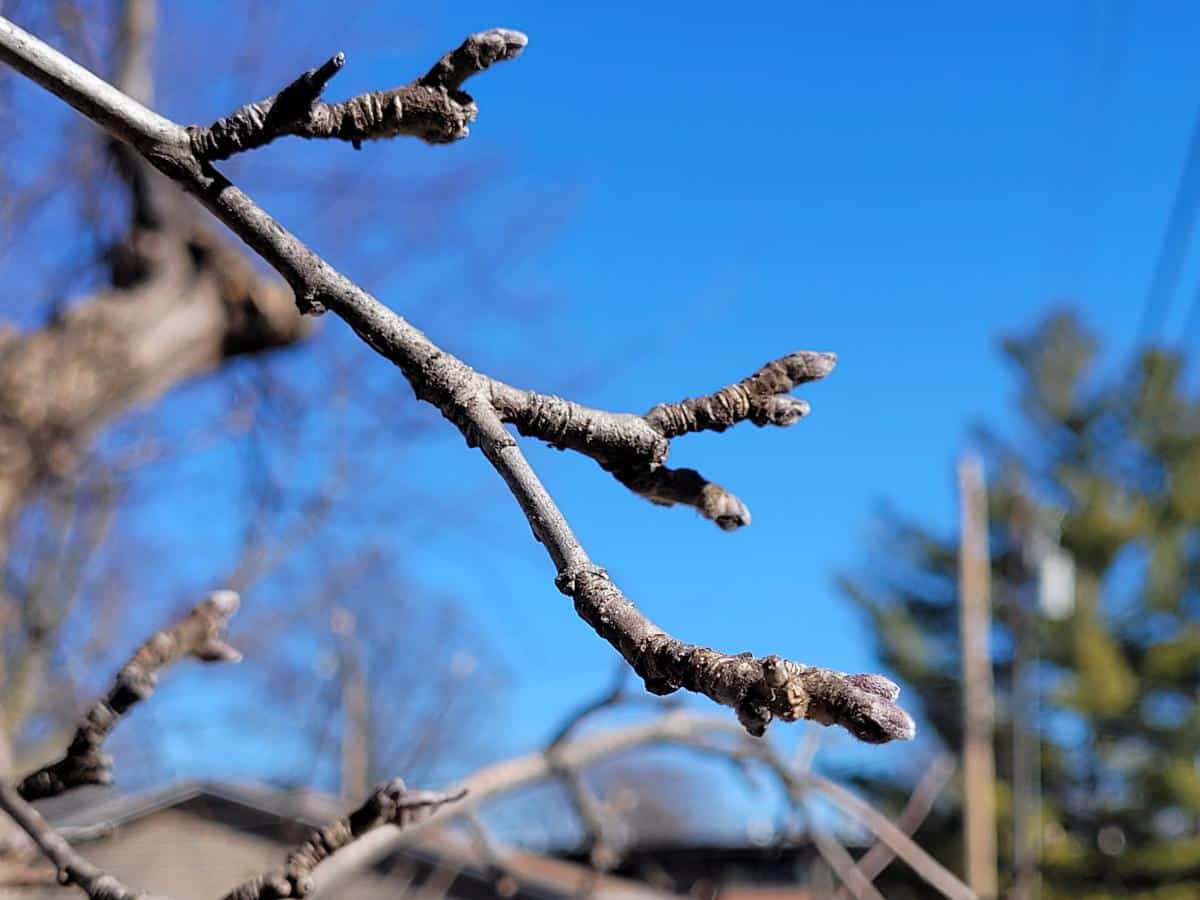
A Checklist of 14 Steps for Winter Pruning
So let’s get started. Here are 14 things to focus on when you’re up on a ladder with the pruners, lopper, and saw.
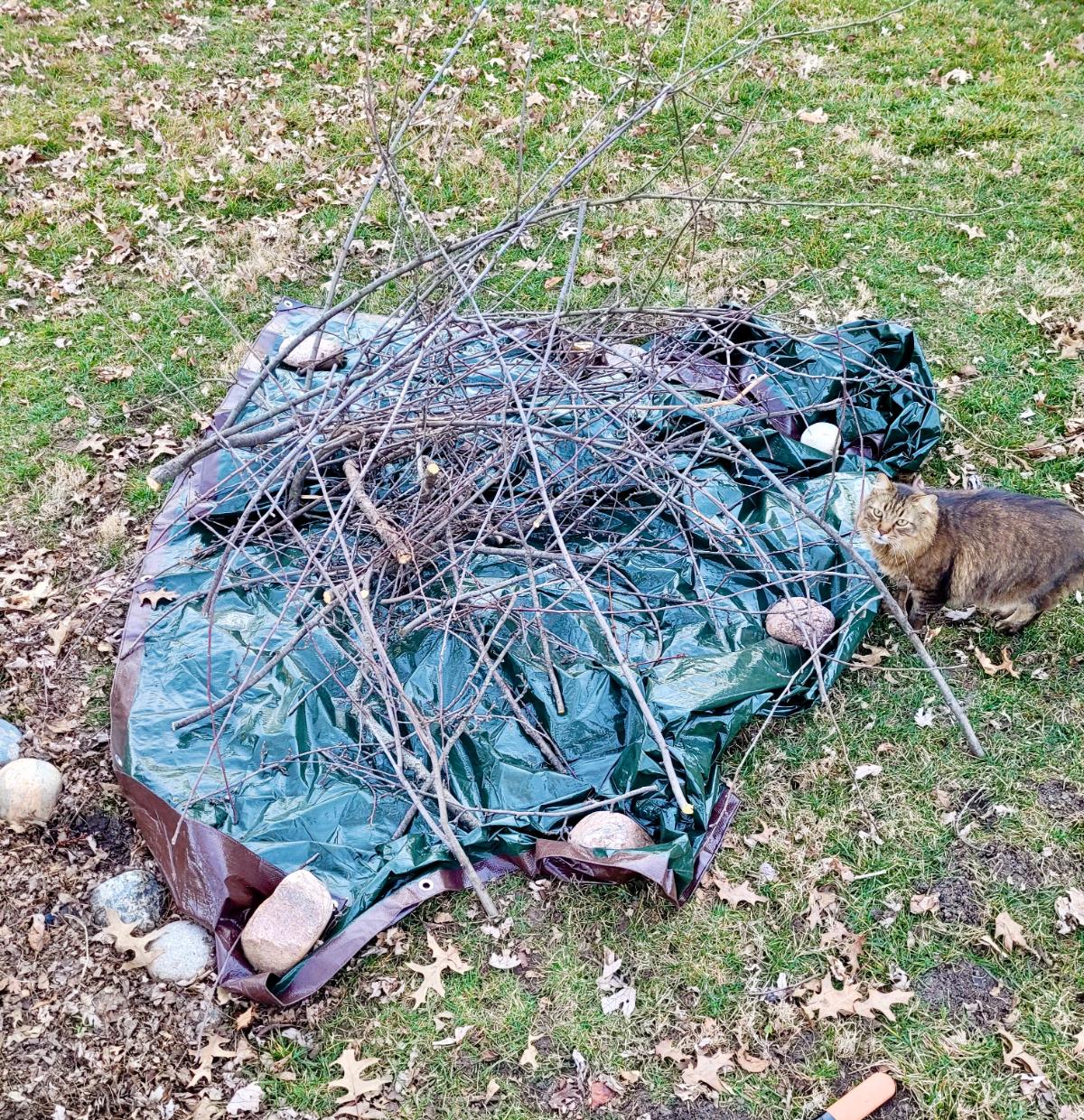
- Lay out a tarp next to the tree. Put some rocks on the tarp to keep it in place if the wind is blowing. Drop cut branches on the tarp as you work. When the job is finished, grab the ends of the tarp and drag the branches over to the brush pile.
- Make the right kind of cuts so the apple tree can close the wounds and protect itself from infection. Again, make sure all tools are sharp for a clean cut. Don’t leave stubs sticking out.
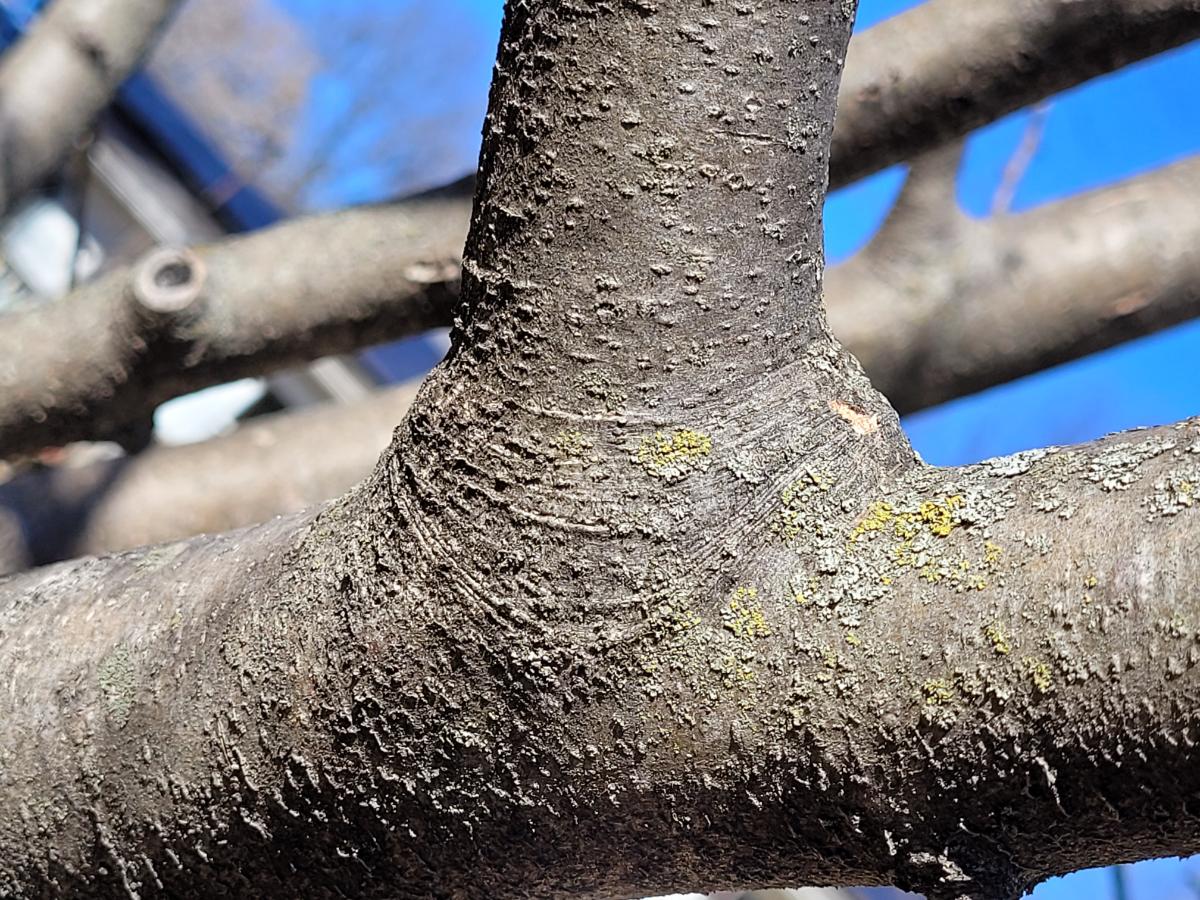
- Cut just above the branch collar. This is a swollen area where the branch attaches to the trunk. When a branch is cut off, the collar will slowly cover the wound and seal it off. Cutting a branch flush to the trunk removes this collar. Then the tree cannot heal, and water and insects can enter the tree and rot it.
- Remove suckers from the base of the tree. Suckers are shoots growing up from the apple tree’s roots that are trying to make some new trees. If your apple tree has a bulge at the base of the trunk, it is likely grafted onto a hardy rootstock, and these suckers will bear low-quality fruit if planted. Suckers also steal energy from the main tree. Cut them off as close as possible to where they sprout from the trunk or roots.

- Remove watersprouts that grow straight up toward the sky. Watersprouts are smooth and straight shoots that bear only vegetation. They clutter the canopy and take energy away from the fruiting branches. Fruiting branches (ideally) will grow horizontally, and they have short spurs coming out of them that bear flowers and apples.
When I asked my Grandma Mary how to prune an apple tree, she said, “Cut off any branches that are reaching straight up to the sky.” It’s a good rule of thumb, especially if you are trying to grow an open- or vase-pruned apple tree.
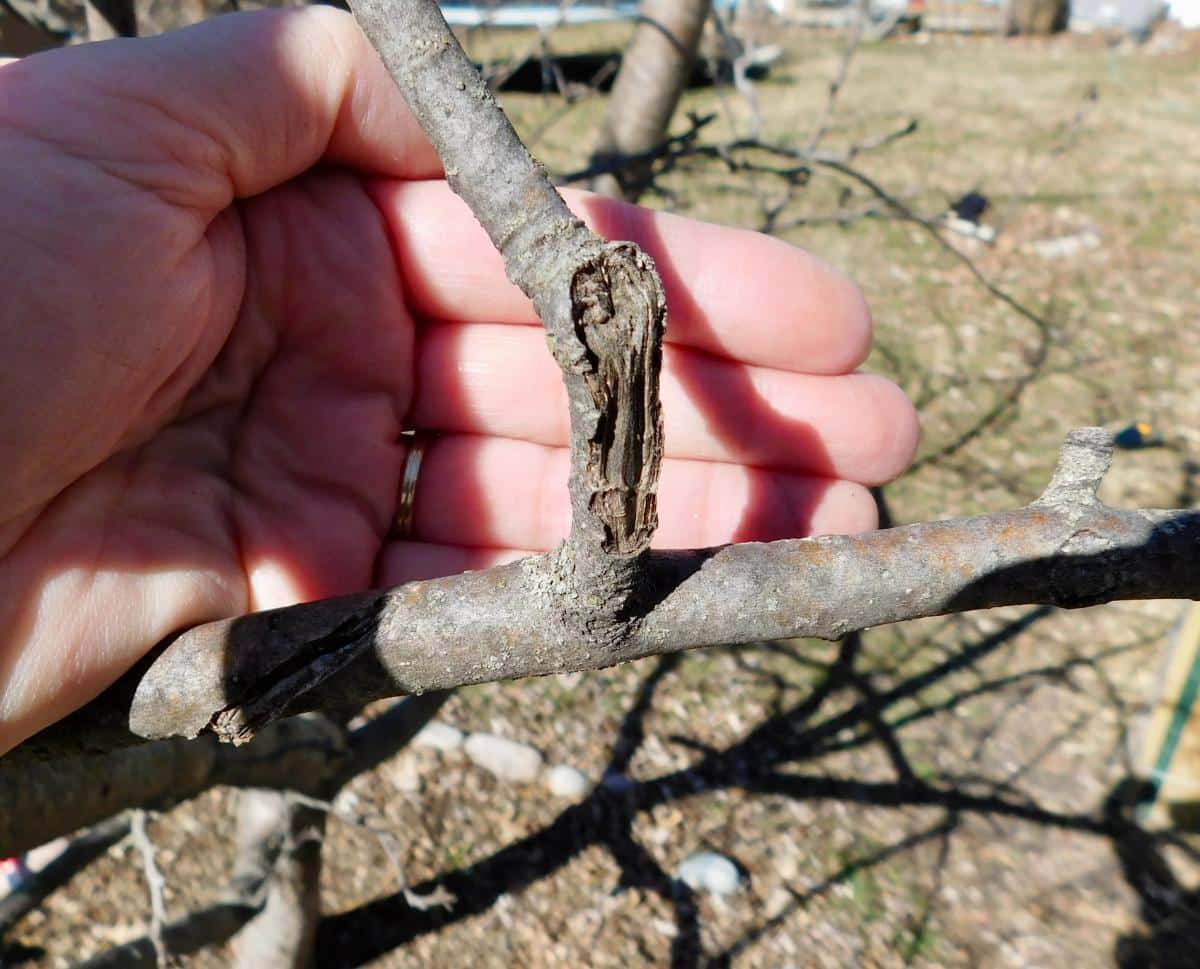
- Cut off dead, diseased, and damaged branches and limbs, even if the wound appears to be healed. Wounded branches can become a liability, introducing rot and infection into the main branches.
- Prune low branches that reach toward the ground, especially if they’re clotheslining people as they walk past.
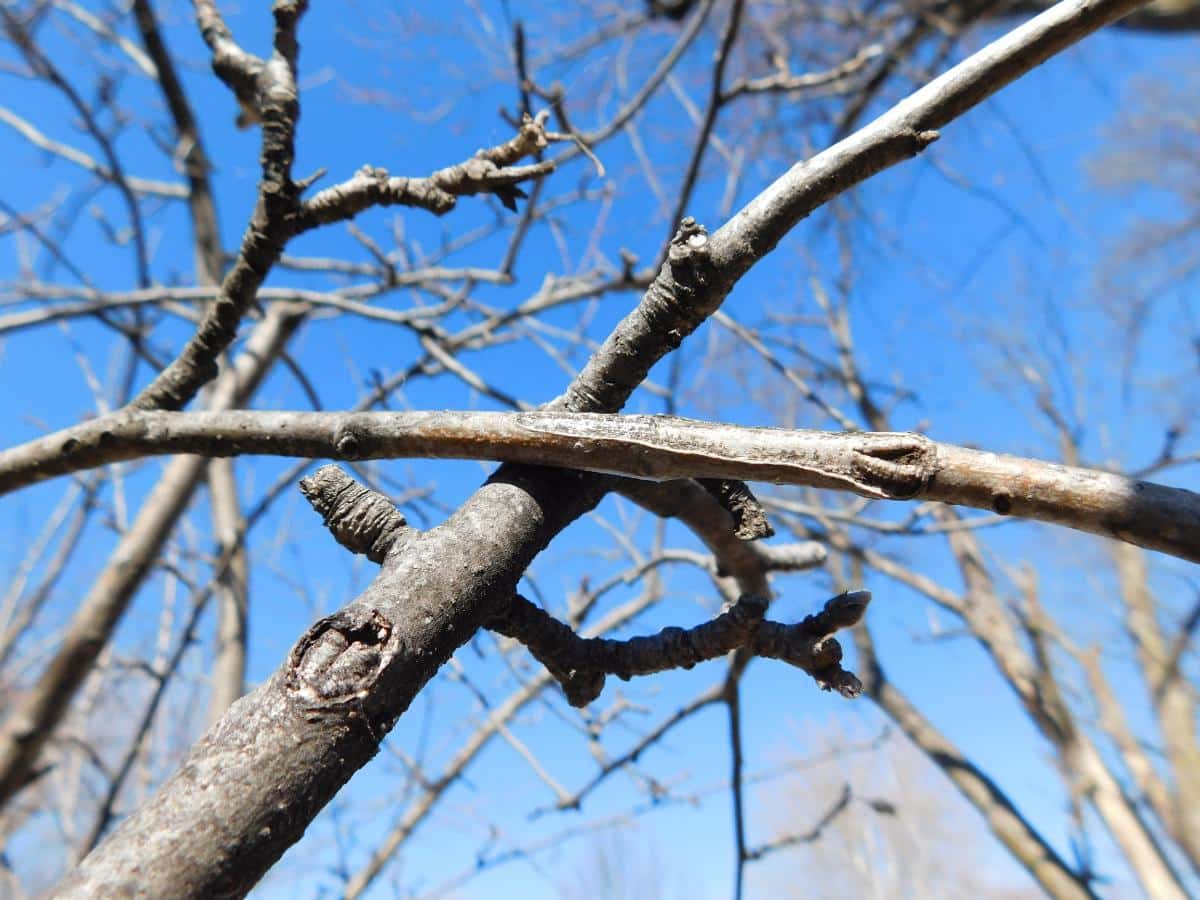
- Remove crossed branches. Here’s another place where branches could potentially create a wound. Remove any crossed branches that are rubbing together. Keep the branch that grows away from the center of the tree; cut off the branch that grows inward.
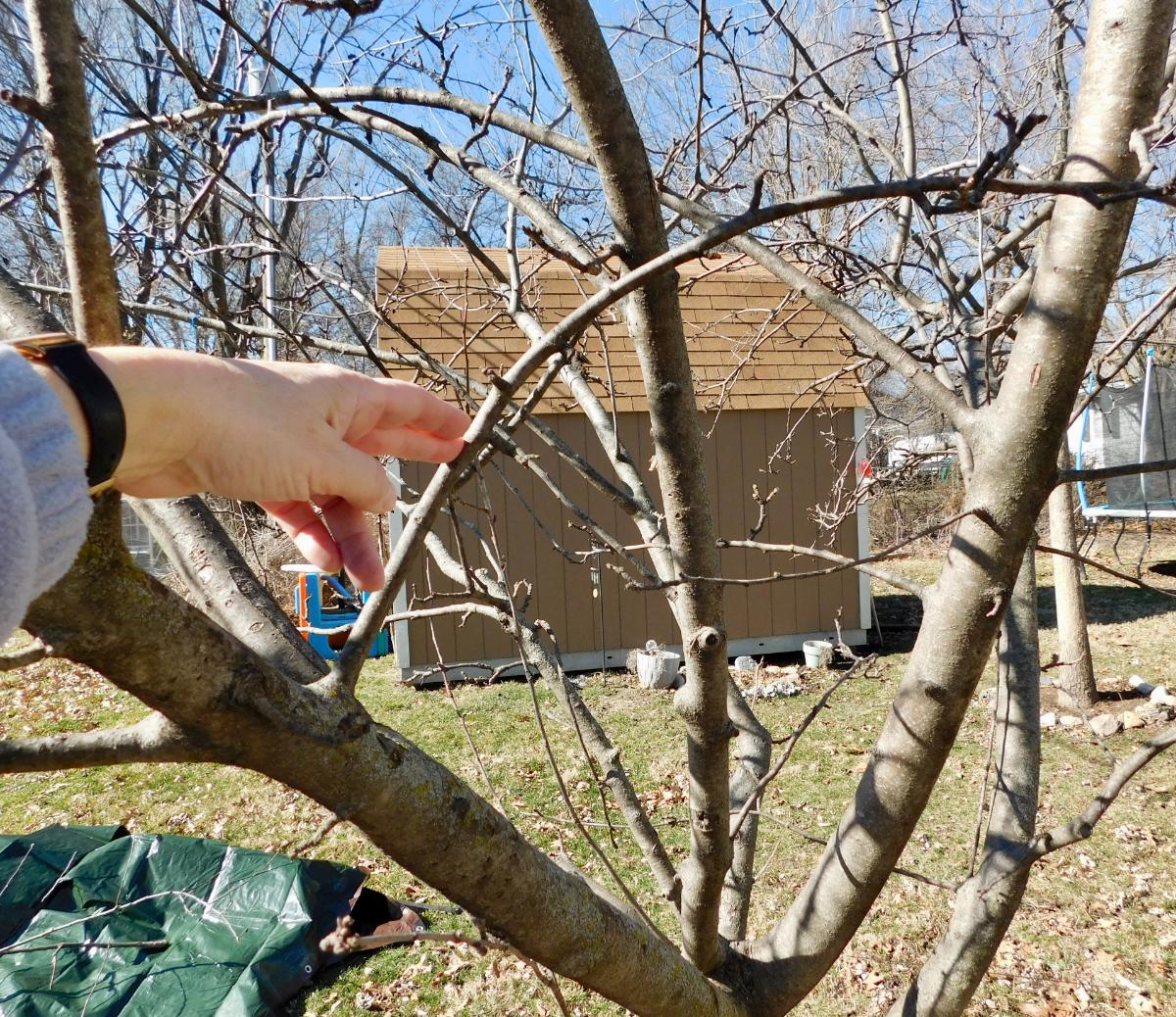
- Prune branches growing into the center of the tree. Removing these will open the inside of the tree for improved air circulation. The aim here is increased air circulation and more sunlight to ripen the apples and make them red. You want to have a tree that is open enough for a winter robin to fly straight through it.
- Keep sturdy branches. The sturdiest branches are at a 60-degree angle to the trunk. To eyeball a 60-degree angle, imagine the trunk is the minute hand pointing at 12, while the branch is pointing at 10 or 2 o’clock.
- Keep vigorous branches – these have glossy bark. Old branches will have ragged, scaly bark.
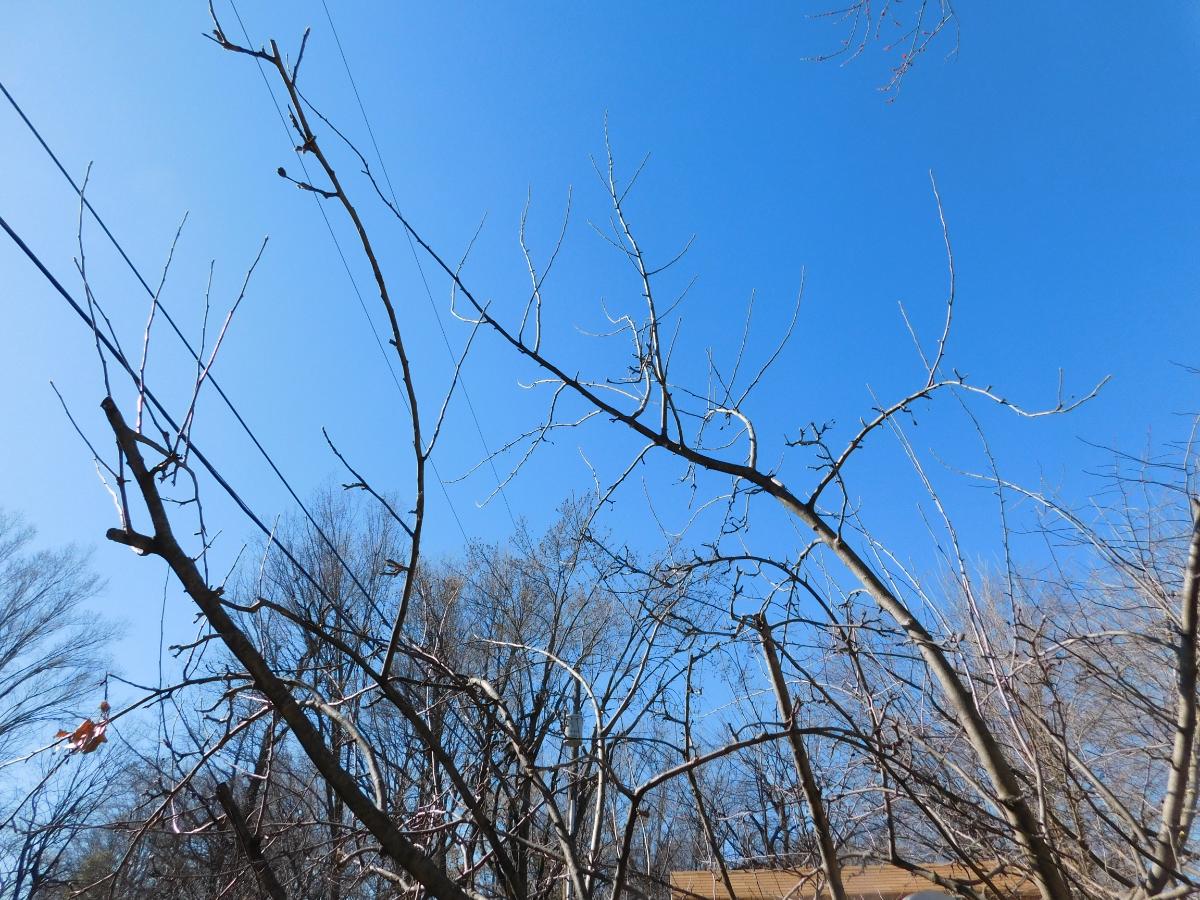
- Choose the leader branch. In the picture above, we have a small group of branches, all vying to be the tallest, the leader branch. Choose one branch to be the central trunk of the apple tree. Then, prune back all the other branches around it to make them shorter so it can be the champion. An apple tree with a central leader should have a pyramidical shape.
- …Unless you want an open-pruned tree. If you’d rather keep the apple branches closer to the ground, cut off these skyward-pointing branches. Keeping branches lower makes it easier to pick apples and prune the tree. Over the years, an open-pruned apple tree maintained this way will develop into an umbrella shape. Most of the orchards near me prune their trees this way.
- Snip back the main branches. Clip several inches off the ends of all the main branches, making the cut just above an outward-facing bud. Heading back the branches will encourage the growth of fruiting spurs (i.e., the short shoots that bear fruit).
Pruning a Brand-New Apple Tree
A newly planted apple tree will need to be pruned differently for best fruiting, especially if it’s only a few years old. Read more about how to prune them.
- Read more: 12 Tips for Planting Fruit Trees + How to Do It
- Read more: 12 Low-Maintenance Fruit Trees Anyone Can Grow
- Read more: A Complete Guide to Basic Grafting Techniques

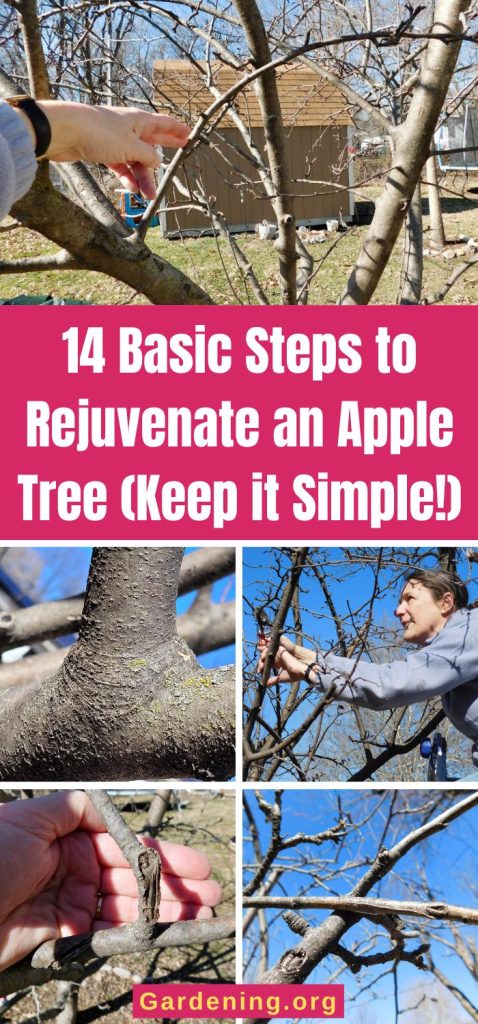
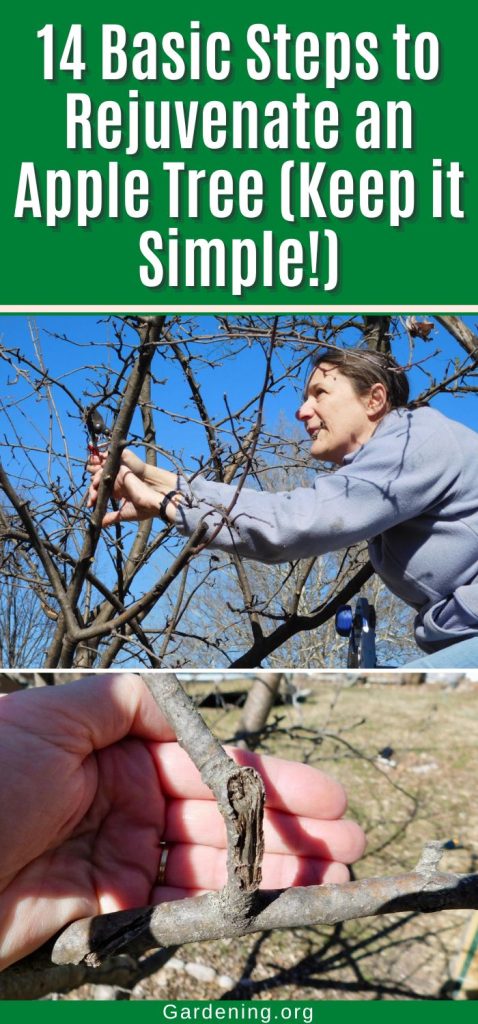

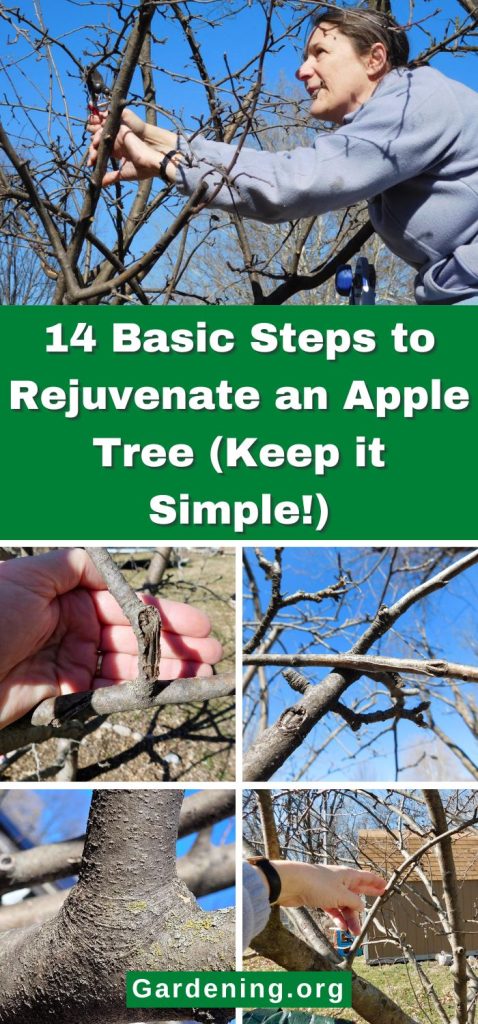
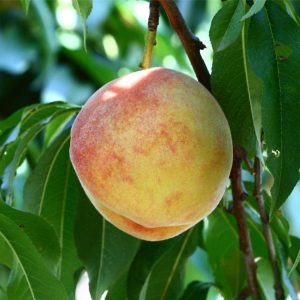


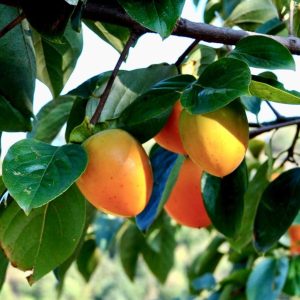
Sandy Franzen
Should pear trees be pruned in the same manner as apple trees?
Rosefiend Cordell
Yes, I forgot to mention that! Pears can be pruned in the same way as apples. The stone fruits (peaches, plums, apricots, etc) are dealt with a little differently.